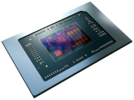AMD Ryzen 5 7540U vs Intel Celeron N4500
AMD Ryzen 5 7540U
► remove from comparison
The AMD Ryzen 5 7540U is a fast mid-range laptop processor of the Phoenix series. It offers 6 cores (hexa core) based on the Zen 4 architecture that supports hyperthreading (12 threads). The cores clock from 3.2 (base) up to 4.9 GHz (single core boost). The processor includes 6 MB L2 cache and 16 MB L3 cache.
Thanks to the new Zen 4 architecture and higher clock speeds, the R5 7540U is clearly faster than the old Ryzen 5 6600U (Zen 3, 6 cores, 4.5 GHz). Compared to the similar 7640U, the 7540U offers a lower base clock and a slower iGPU.
The chip integrates a modern and fasts RDNA 3 graphics card (iGPU) called Radeon 740M with 4 of the 12 CUs and 2.5 GHz clock speed. Furthermore, the Phoenix series include a video engine with AV1 de- and encoding and a dual-channel DDR5-5600 / LPDDR5x-7500 memory controller (with ECC support). The new Xilinx FPGA based XDNA AI accelerator (Ryzen AI) is not included in the 7540U. The connectivity features includes 2 possible USB 4 (40 Gbps) ports and 20 PCIe 4.0 lanes for a GPU and SSDs.
The Phoenix series uses a single monolithic design (unlike the chiplet design of the 7045HX series) and is manufactured in the modern 4nm process at TSMC. The TDP can be configured between 15 and 30 Watt (28 Watt default).
Intel Celeron N4500
► remove from comparison
The Intel Celeron N4500 is a dual-core SoC of the Jasper Lake series that is primarily intended for inexpensive notebooks and was announced in early 2021. The two Tremont CPU cores clock between 1.1 and 2.8 GHz (single core Burst) and offer no HyperThreading. The N4500 uses 1.5 MB L2 and 4 MB L3 cache. The chip is manufactured on the first-gen 10 nm Intel process.
Architecture
The processor architecture is called Tremont and a complete redesign compared to the old Golmont Plus cores in the predecessor. According to Intel, the single thread performance of a core could is up two 30% better on average (10 - 80% in all tests of SPECint and SPECfp).
Features
In addition to the dual-core CPU block, the SoC integrates a 16 EU Intel UHD Graphics GPU clocked from 350 - 750 MHz and a dual-channel DDR4 / quad-channel LPDDR4(x) memory controller (up to 16 GB, up to 2933 MHz). The chip now also partly integrates Wi-Fi 6 (Gig+), 8 PCIe 3.0 lanes, 14 USB 2.0/ 3.2 ports and two SATA 6.0 ports. The package got bigger and measures 35 x 24 mm (compared to 25 x 24 mm for the N5030 e.g.). The SoC is directly soldered to the mainboard (BGA) and can't be easily replaced.
Performance
The average N4500 in our database shapes up to be a fairly slow processor, its multi-thread benchmark scores only just matching those of the Core i3-4010U. (The latter saw the light of day in 2013 as a lower mid-range, dual-core CPU designed for use in ultraportable laptops.) In other words, expect the Celeron to be painfully slow in all but the most basic activities.
You mileage may vary depending on how high the CPU power limits are.
Power consumption
Like most N-class Intel chips, the Celeron has a default TDP (also known as the long-term power limit) of 6 W. This is not much at all and thus good enough for passively cooled tablets, laptops, mini-PCs.
The Celeron N4500 is built with Intel's 2nd generation 10 nm process (not 10 nm SuperFin or Intel 7) for low, as of mid 2023, energy efficiency.
| Model | AMD Ryzen 5 7540U | Intel Celeron N4500 | ||||||||||||||||||||||||||||||||||||||||||||||||||||
| Series | AMD Phoenix (Zen 4, Ryzen 7040) | Intel Jasper Lake | ||||||||||||||||||||||||||||||||||||||||||||||||||||
| Codename | Phoenix (Zen4) | Jasper Lake | ||||||||||||||||||||||||||||||||||||||||||||||||||||
| Series: Jasper Lake Jasper Lake |
|
| ||||||||||||||||||||||||||||||||||||||||||||||||||||
| Clock | 3200 - 4900 MHz | 1100 - 2800 MHz | ||||||||||||||||||||||||||||||||||||||||||||||||||||
| L1 Cache | 384 KB | |||||||||||||||||||||||||||||||||||||||||||||||||||||
| L2 Cache | 6 MB | 1.5 MB | ||||||||||||||||||||||||||||||||||||||||||||||||||||
| L3 Cache | 16 MB | 4 MB | ||||||||||||||||||||||||||||||||||||||||||||||||||||
| Cores / Threads | 6 / 12 6 x 4.9 GHz AMD Zen 4 | 2 / 2 | ||||||||||||||||||||||||||||||||||||||||||||||||||||
| TDP | 28 Watt | 6 Watt | ||||||||||||||||||||||||||||||||||||||||||||||||||||
| Technology | 4 nm | 10 nm | ||||||||||||||||||||||||||||||||||||||||||||||||||||
| Die Size | 178 mm2 | |||||||||||||||||||||||||||||||||||||||||||||||||||||
| max. Temp. | 100 °C | 105 °C | ||||||||||||||||||||||||||||||||||||||||||||||||||||
| iGPU | AMD Radeon 740M ( - 2500 MHz) | Intel UHD Graphics (Jasper Lake 16 EU) (350 - 750 MHz) | ||||||||||||||||||||||||||||||||||||||||||||||||||||
| Architecture | x86 | x86 | ||||||||||||||||||||||||||||||||||||||||||||||||||||
| Announced | ||||||||||||||||||||||||||||||||||||||||||||||||||||||
| Manufacturer | www.amd.com | ark.intel.com | ||||||||||||||||||||||||||||||||||||||||||||||||||||
| Socket | BGA1338 | |||||||||||||||||||||||||||||||||||||||||||||||||||||
| Features | DDR4-2933/LPDDR4x-2933 RAM, PCIe 3, GNA, MMX, SSE, SSE2, SSE3, SSSE3, SSE4.1, SSE4.2, SMEP, SMAP, EIST, TM1, TM2, Turbo, SST, AES-NI, RDRAND, RDSEED, SHA |


 Deutsch
Deutsch English
English Español
Español Français
Français Italiano
Italiano Nederlands
Nederlands Polski
Polski Português
Português Русский
Русский Türkçe
Türkçe Svenska
Svenska Chinese
Chinese Magyar
Magyar